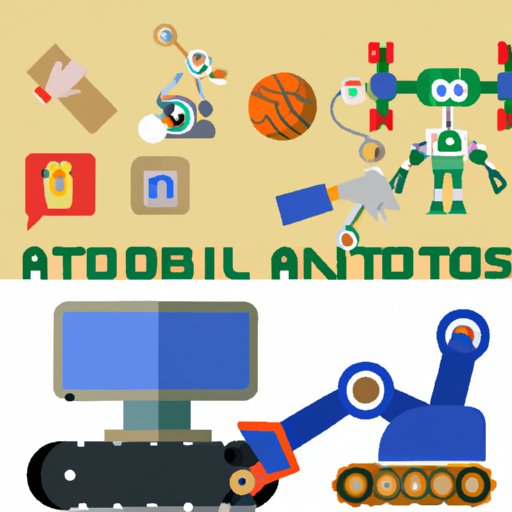Introduction
The term “autonomous robot” often conjures up images of a robotic humanoid roaming around performing tasks on its own. But what exactly is an autonomous robot? An autonomous robot is a machine capable of sensing its environment and navigating by itself without direct human control. Autonomous robots have become increasingly important in recent years as they are used to automate various processes and reduce labor costs. This article explores what autonomous robots are, how they work, and how they are being used in the modern world.
Exploring Autonomous Robots: A Beginner’s Guide
To understand autonomous robots, it is important to first define key terms related to them. Autonomous robots are self-operating machines that use sensors and software to interact with their environment. They are programmed to respond to their environment by taking certain actions or making decisions without human input. Autonomous robots can be divided into two categories: mobile robots and stationary robots. Mobile robots are able to move around and interact with their environment, while stationary robots remain in one place and perform specific tasks.
Autonomous robots typically use artificial intelligence (AI) to process data from sensors, allowing them to make decisions about their environment. AI enables autonomous robots to learn from their experiences and adapt to changing conditions. For example, a robot may use AI to recognize objects or obstacles and adjust its behavior accordingly. Autonomous robots also require programming in order to function correctly. Programming involves writing code that allows the robot to identify objects, perceive its surroundings, and take appropriate action.
Understanding Autonomous Robots and Their Uses
Autonomous robots are used in a variety of industries, including manufacturing, healthcare, agriculture, and transportation. In manufacturing, autonomous robots are used to automate production lines and increase efficiency. In healthcare, autonomous robots are used for medical procedures such as surgery and drug delivery. In agriculture, autonomous robots are used to monitor crops, irrigation systems, and soil health. In transportation, autonomous robots are used for autonomous vehicles and delivery drones.
Autonomous robots can also be used for more mundane tasks such as vacuuming floors and mowing lawns. In fact, many household tasks can now be automated using robotic technology. For example, robotic vacuum cleaners are becoming increasingly popular due to their ability to clean floors without human intervention. Similarly, robotic lawn mowers can be programmed to cut grass at predetermined intervals, saving time and effort.

The Pros and Cons of Autonomous Robots
Like any technology, autonomous robots come with both benefits and drawbacks. On the positive side, autonomous robots can help reduce labor costs and improve efficiency in the workplace. They can also reduce the risk of injury in hazardous environments such as nuclear power plants and chemical factories. Additionally, autonomous robots can perform repetitive tasks more quickly and accurately than humans, freeing up workers for higher-value tasks.
On the other hand, there are some drawbacks to using autonomous robots. For example, autonomous robots are expensive to purchase and maintain. Additionally, they require a high level of technical expertise to program and operate properly. Finally, autonomous robots may not be able to handle unexpected situations as well as humans, which can lead to costly mistakes.

Autonomous Robots in the Modern Age
In recent years, there has been a surge in the development of autonomous robots. Companies such as Boston Dynamics, Alphabet Inc., and Softbank Robotics are leading the way in developing autonomous robots for commercial applications. These companies are researching and developing robots that can perform complex tasks such as search and rescue, warehouse logistics, and agricultural harvesting. Additionally, there has been a significant increase in the number of autonomous vehicle manufacturers, such as Tesla and Waymo.
As autonomous robots become more advanced, governments and regulatory bodies are beginning to create rules and regulations to ensure their safe operation. For example, the European Union recently passed a directive requiring all autonomous vehicles to be equipped with a “black box” to record data in case of an accident. Similarly, the U.S. Department of Transportation has proposed guidelines for the safe deployment of autonomous vehicles on public roads.

Autonomous Robots: The Future of Automation
Autonomous robots are poised to revolutionize the way we live and work. As technology advances, autonomous robots will become increasingly capable of performing complex tasks. In the near future, autonomous robots could be used for a wide range of applications, from search and rescue to factory automation. Additionally, autonomous robots could be used to explore space and other hostile environments.
The future of autonomous robots is uncertain, but one thing is clear: they will play an increasingly important role in our lives. To prepare for this future, governments, businesses, and individuals must ensure that autonomous robots are regulated responsibly and safely integrated into society.
Conclusion
Autonomous robots are a rapidly advancing technology that has the potential to revolutionize the way we live and work. Autonomous robots are capable of autonomously sensing and navigating their environment, and they can be used to automate a variety of tasks. While autonomous robots come with both benefits and drawbacks, their potential is undeniable. As autonomous robots become more advanced, it is essential that governments, businesses, and individuals prepare for their integration into society.
(Note: Is this article not meeting your expectations? Do you have knowledge or insights to share? Unlock new opportunities and expand your reach by joining our authors team. Click Registration to join us and share your expertise with our readers.)
